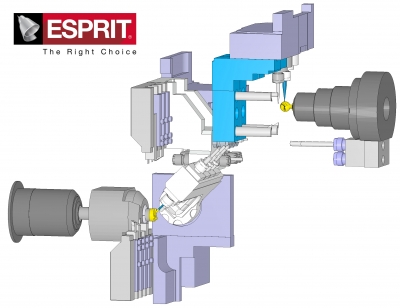
DP Technology announces a comprehensive product update, called ESPRIT 2020, for their computer-aided manufacturing (CAM) software. Among the most significant developments are updates to the software’s computer-aided design (CAD) interfaces and new or improved solutions for specific machine tools.
ESPRIT 2020 features plentiful updates for Swiss-type machining. This technique is defined by its small, often intricate parts. Medical devices, such as bone screws, are typically manufactured on Swiss-type machines. ESPRIT’s 2020 update introduces or enhances support for 200 different Swiss-type machine models, including:
● Citizen D25, which features three channels, 3x Y-axis, 3x Z-axis, B-axis front and back
● Star SV 38R, which features three channels and a B-axis
● Tsugami SS38, a chucker-convertible sliding headstock lathe with B-axis
● Tornos machines
● Seamless integration of laser cutting operations for Tsugami and Citizen
The 2020 update also includes updated support for the latest CAD software, including:
● SolidWorks 2020
● SolidEdge 2020
● PTC Creo 6
- NX 1847
Improved CAD support allows users to better design and visualize parts before manufacturing begins. CAD modeling is an integral part of designing and optimizing any new part, and different software types specialize in different modeling techniques.
Additionally, ESPRIT 2020 expands mill-turn support to the following machines:
● Index G200 and G220, featuring two and three turrets and a disk turret mounted on a B-axis
● Miyano BNE 51 MSY, featuring three X-axes and three Z-axes
● Traub TNX, featuring simultaneous independent machining with up to four tool carriers
- CMZ TTL, featuring two turrets and two spindles
Enhanced profile threading and probing capabilities round out the product release.
“Product releases are always exciting for us, because often we’re providing a solution where one did not previously exist,” says Tania Campanelli, Director of Research and Development at DP Technology. “2020 is no different. We look forward to more users discovering why ESPRIT is the right choice.”
Contact Details
Related Glossary Terms
- computer-aided design ( CAD)
computer-aided design ( CAD)
Product-design functions performed with the help of computers and special software.
- computer-aided design ( CAD)2
computer-aided design ( CAD)
Product-design functions performed with the help of computers and special software.
- computer-aided manufacturing ( CAM)
computer-aided manufacturing ( CAM)
Use of computers to control machining and manufacturing processes.
- lathe
lathe
Turning machine capable of sawing, milling, grinding, gear-cutting, drilling, reaming, boring, threading, facing, chamfering, grooving, knurling, spinning, parting, necking, taper-cutting, and cam- and eccentric-cutting, as well as step- and straight-turning. Comes in a variety of forms, ranging from manual to semiautomatic to fully automatic, with major types being engine lathes, turning and contouring lathes, turret lathes and numerical-control lathes. The engine lathe consists of a headstock and spindle, tailstock, bed, carriage (complete with apron) and cross slides. Features include gear- (speed) and feed-selector levers, toolpost, compound rest, lead screw and reversing lead screw, threading dial and rapid-traverse lever. Special lathe types include through-the-spindle, camshaft and crankshaft, brake drum and rotor, spinning and gun-barrel machines. Toolroom and bench lathes are used for precision work; the former for tool-and-die work and similar tasks, the latter for small workpieces (instruments, watches), normally without a power feed. Models are typically designated according to their “swing,” or the largest-diameter workpiece that can be rotated; bed length, or the distance between centers; and horsepower generated. See turning machine.
- threading
threading
Process of both external (e.g., thread milling) and internal (e.g., tapping, thread milling) cutting, turning and rolling of threads into particular material. Standardized specifications are available to determine the desired results of the threading process. Numerous thread-series designations are written for specific applications. Threading often is performed on a lathe. Specifications such as thread height are critical in determining the strength of the threads. The material used is taken into consideration in determining the expected results of any particular application for that threaded piece. In external threading, a calculated depth is required as well as a particular angle to the cut. To perform internal threading, the exact diameter to bore the hole is critical before threading. The threads are distinguished from one another by the amount of tolerance and/or allowance that is specified. See turning.







